Python 中使用 unittestreport 之 生成 HTML 报告、失败用例重运行、邮件发送测试报告、推送结果到钉钉、企业微信
关于 unittestreport 最初在开发的时候,最初只是计划开发一个unittest生成html测试报告的模块,所以起名叫做unittestreport。在开发的过程中结合使用的小伙伴的一些反馈,所以慢慢的扩展了更多的功能进去。之前在写unittestreport的时候,也陆续写了几遍关于unittestreport相关功能的使用,每次都是一个特定的功能,这边给出一遍系统的使用文档来给大家介绍一下unittestreport的功能。
关于 unittestreport 是什么? 官方地址:https://pypi.org/project/unittestreport/
- unittestreport是基于unittest开发的的一个功能扩展库,为unittest提供了一些常用的扩展功能:
- HTML测试报告生成
- 测试用例失败重运行
- 发送测试结果及报告到邮箱
- unittest数据驱动
- 测试结果钉钉通知
一、安装 unittestreport (report译:瑞泡特)
在 https://pypi.org/ 中搜索 unittestreport 就可以查看 官方文档
使用文档:https://unittestreport.readthedocs.io/en/latest/
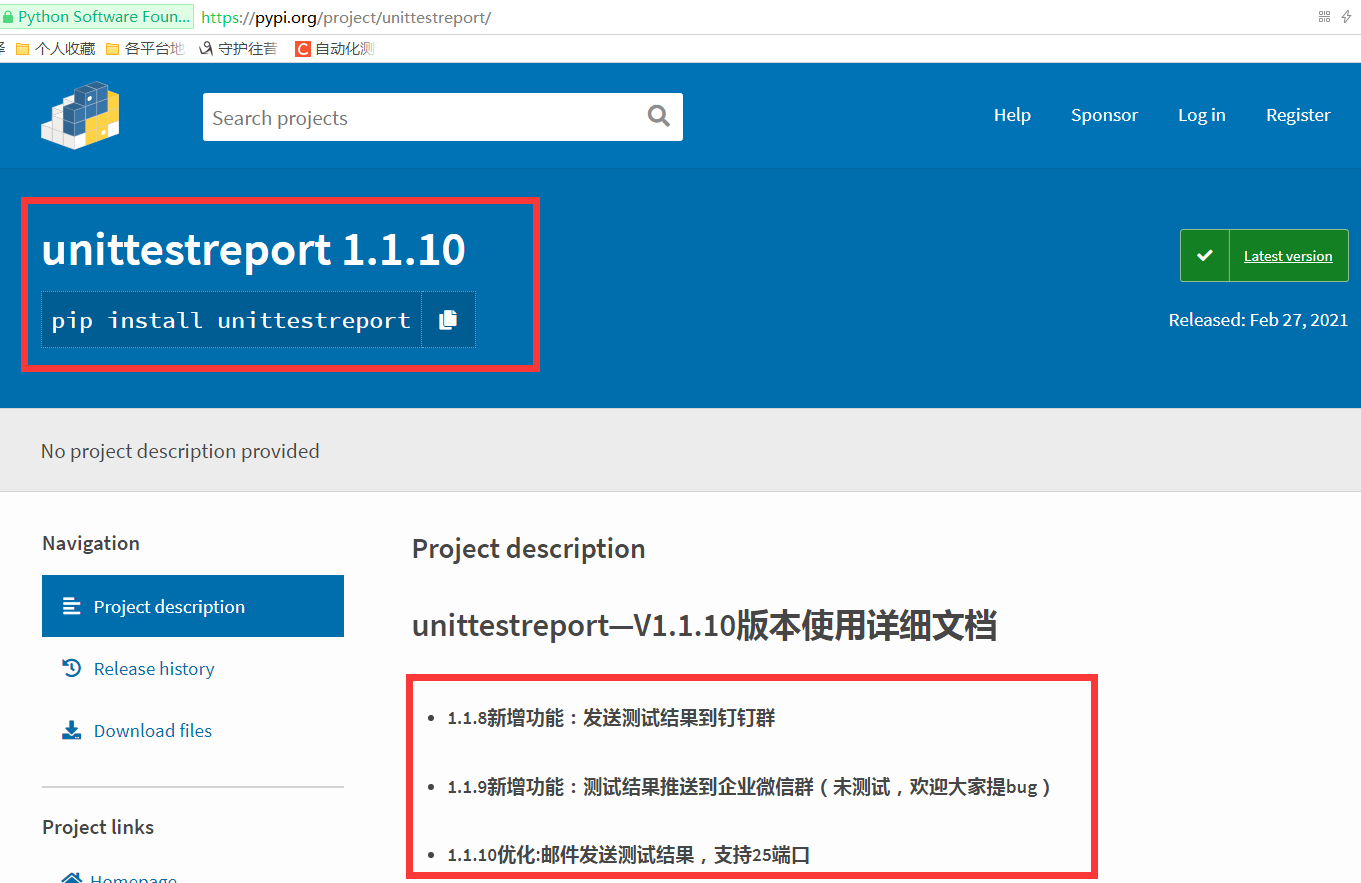
在 cmd 中使用 pip 安装:

二.使用 TestRunner 模块生成 HTML 报告
# 加载测试用例的方法:discover(迪斯卡瓦)方法 import unittest from unittestreport import TestRunner # 手机测试用例,使用绝对路径加载测试用例,使用 r 进行转码 one_suite = unittest.defaultTestLoader.discover(r"D:\zj_danyuan\Python_0715_unittest") # 执行用例 # 1.需要创建执行器对象,使用 unittest 当中的 TestRunner(译:泰斯特.软那儿) """ :param suites: 测试套件 :param filename: 报告文件名 :param report_dir:报告文件的路径 :param title:测试套件标题 :param templates: 可以通过参数值1或者2,指定报告的样式模板,目前只有两个模板 :param tester:测试者 """ one_runner = TestRunner(one_suite, filename="python.html", report_dir=r"D:\zj_danyuan\Python_0715_unittest\logs", title="演示用例运行产生的测试报告", tester="守护", desc="第一个报告", templates=1 ) # 2.运行套件 one_runner.run()
执行测试用例
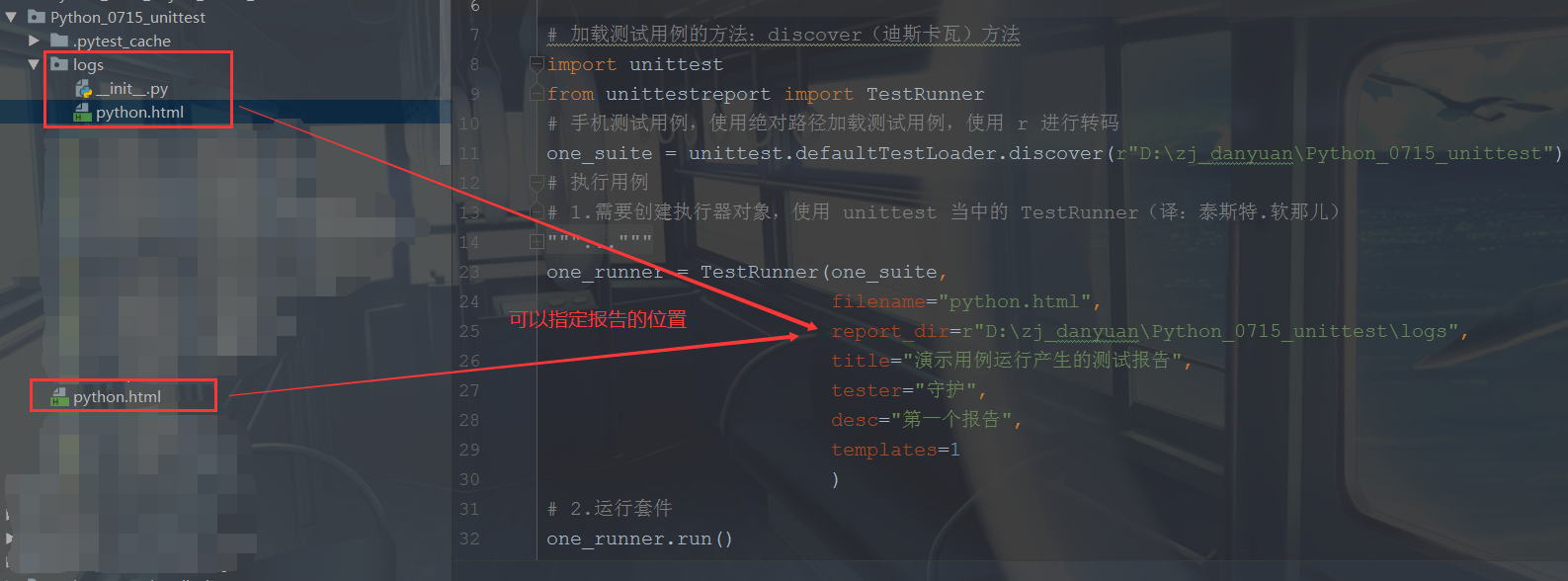
使用浏览器打开测试报告

三、Unittestreport 之 DataDrivenTest (DDT)中数据驱动使用
关于数据驱动这边就不给大家做过多的介绍了,数据驱动的目的是将测试数据和用例逻辑进行分离,提高代码的重用率,以及用例的维护,关于数据驱动本,unittestreport.dataDriver模块中实现了三个使用方法,支持使用列表(可迭代对象)、json文件、yaml文件来生成测试用例,接来分别给大家介绍一下使用方法:
1、使用介绍
from unittestreport.dataDriver
import ddt, list_data,json_data,yaml_data
-
第一步:使用ddt装饰测试用例类
-
第二步:根据使用的数据选择对应的方法进行驱动
2、使用案例
import unittest from unittestreport import ddt, list_data, json_data, yaml_data """ 判断五组数据是否相等 """ test_cases = [ (11, 11), (11, 12), (14, 14), (17, 17), (19, 19), ] @ddt class TestDome(unittest.TestCase): @list_data(test_cases) def test_demo(self, case): a, b = case self.assertEqual(a, b)
示例1、用例保存在可迭代对象中(如列表):使用LIST_DATA
from unittestreport import ddt, list_data @ddt class TestClass(unittest.TestCase): cases = [{'title': '用例1', 'data': '用例参数', 'expected': '预期结果'}, {'title': '用例2', 'data': '用例参数', 'expected': '预期结果'}, {'title': '用例3', 'data': '用例参数', 'expected': '预期结果'}] @list_data(cases) def test_case(self, data): pass
示例2、用例保存在JSON文件中:使用JSON_DATA
from unittestreport import ddt,json_data @ddt class TestClass(unittest.TestCase): @json_data(apitest) def test_case(self, data): pass
json文件中的数据格式
- cases.json文件
[ { "title": "用例1", "data": "用例参数", "expected": "预期结果" }, { "title": "用例2", "data": "用例参数", "expected": "预期结果" }, { "title": "用例3", "data": "用例参数", "expected": "预期结果" } ]
示例3、用例保存在YAML文件中:使用YAML_DATA
from unittestreport import ddt,yaml_data @ddt class TestClass(unittest.TestCase): @yaml_data("C:/xxxx/xxx/cases.yaml") def test_case(self, data): pass
yaml文件中的数据展示
- cases.yaml文件
- title: 用例1 data: 用例参数 expected: 预期结果 - title: 用例2 data: 用例参数 expected: 预期结果 - title: 用例4 data: 用例参数 expected: 预期结果
2、注意点:
-
关于使用ddt的时候进行数据驱动,指定测试报告中的用例描述:
-
测试报告中的用例描述默认使用的是用例方法的文档字符串注释,
-
如果要给每一条用例添加用例描述,需要在用例数据中添加 title 或者 desc 字段,字段对应的数据会自动设置为测试报告中用例的描述

四、测试用例失败重运行
关于 unittest 重运行机制,unittestreport 中提供了两种方式
方式一: RERUN 装饰器
- 使用案例:使用 rerun 装饰失败需要重运行的用例,该用例失败后会自动重运行
from unittestreport import rerun class TestClass(unittest.TestCase): @rerun(count=4, interval=2) def test_case_01(self): a = 100 b = 99 assert a == b
用例运行
runner = TestRunner(test_suite)
runner.run()
参数说明:
- count:用来指定用例失败重运行的次数
- interval:指定每次重运行的时间间隔,默认三秒
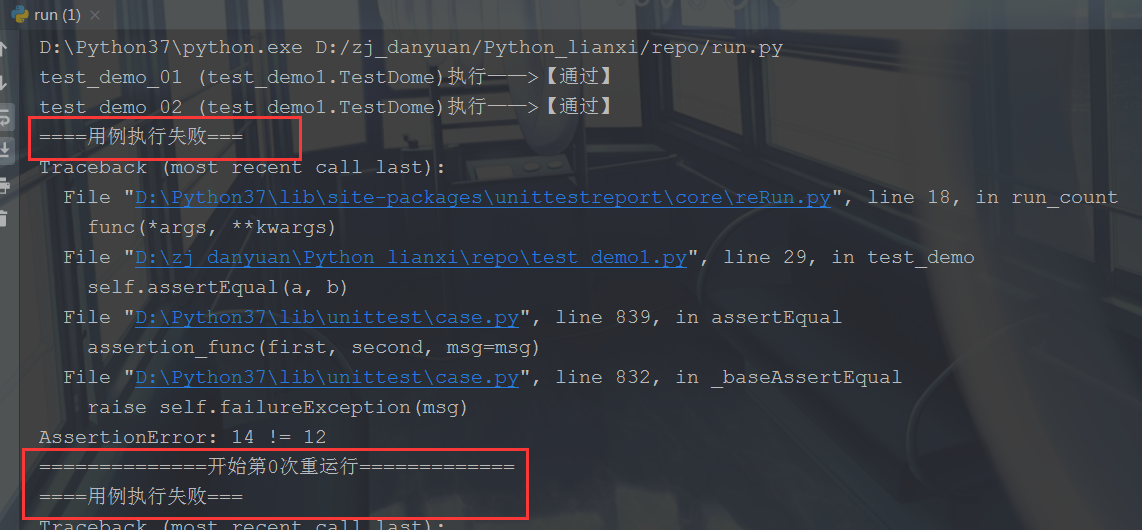
方式二:TESTRUNNER.RERUN方法
-
使用案例:所有的用例失败,只要有失败的用例,会自动重运行该用例
- 用例正常编写即可
- 运行是使用 TestRunner.rerun_run 方法运行
runner = TestRunner(suite=suite)
runner.rerun_run(count=3, interval=2)
参数说明:
- count:用来指定用例失败重运行的次数
- interval:指定每次重运行的时间间隔
五、Unittestreport 多线程执行测试用例
unittestreport 的 TestRunner 模块当中的 run 方法
注意:
- 1、确保际个线程任务测试类)在执行的时候不会出现资源竞争(对全局依赖的数据进行修改)
- 2、确保用例类执行没有先后顺序的依赖关系
from unittestreport import TestRunner def run(self, thread_count=1): """ 支持多线程执行 注意点:如果多个测试类共用某一个全局变量,由于资源竞争可能会出现错误 :param thread_count:线程数量,默认位1 :return:测试运行结果 """ # 将测试套件按照用例类进行拆分 suites = self.__classification_suite() with ThreadPoolExecutor(max_workers=thread_count) as ts: for i in suites: res = TestResult() self.result.append(res) ts.submit(i.run, result=res).add_done_callback(res.stopTestRun) ts.shutdown(wait=True) res = self.__get_reports() return res
用例示例:
一共有20个测试用例,如果不适用多线程 需要20秒
import unittest import time from unittestreport import ddt, list_data, json_data, yaml_data, rerun @ddt class TestDome(unittest.TestCase): @list_data(range(10)) def test_demo(self, case): print(case) time.sleep(1) @ddt class TestDome1(unittest.TestCase): @list_data(range(10)) def test_demo(self, case): print(case) time.sleep(1)
运行文件:
# 加载测试用例的方法:discover(迪斯卡瓦)方法 import unittest from unittestreport import TestRunner # 收集测试用例,使用绝对路径加载测试用例,使用 r 进行转码 one_suite = unittest.defaultTestLoader.discover(r"D:\zj_danyuan\Python_lianxi\repo1") # 执行用例1.需要创建执行器对象,使用 unittest 当中的 TestRunner(译:泰斯特.软那儿) one_runner = TestRunner(one_suite, filename="python.html", report_dir=r"D:\zj_danyuan\Python_lianxi\repo1", title="演示用例运行产生的测试报告", tester="守护", desc="第一个报告", templates=1 ) # 2.多线程运行 one_runner.run(thread_count=2)
使用多线程运行 后为 10秒


六、邮件发送测试报告
unittestreport内部实现了发生测试结果到邮箱的方法,执行完测试用例之后调用发送测试报告的方法即可。发邮件的方法介绍:TestRunner类中实现了send_email方法,可以方便用户,快速发送邮件。
send_email 方法:
def send_email(self, host, port, user, password, to_addrs, is_file=True): """ 发生报告为附件到邮箱 :param host: str类型,(smtp服务器地址) :param port: int类型,(smtp服务器地址端口) :param user: str类型,(邮箱账号) :param password: str类型(邮箱密码) :param to_addrs: str(单个收件人) or list(多个收件人)收件人列表, :return: """ sm = SendEmail(host=host, port=port, user=user, password=password) if is_file: filename = self.email_conent["file"] else: filename = None content = self.email_conent["content"] sm.send_email(subject=self.title, content=content, filename=filename, to_addrs=to_addrs)
使用案例:
runner = TestRunner(suite) runner.run() runner.send_email(host="smtp.qq.com", port=465, user="musen_nmb@qq.com", password="algmmzptupjccbab", to_addrs="3247119728@qq.com")
参数介绍
- host: smtp服务器地址
- port:端口
- user:邮箱账号
- password:smtp服务授权码
- to_addrs:收件人邮箱地址(一个收件人传字符串,多个收件人传列表)
收到的邮件样式
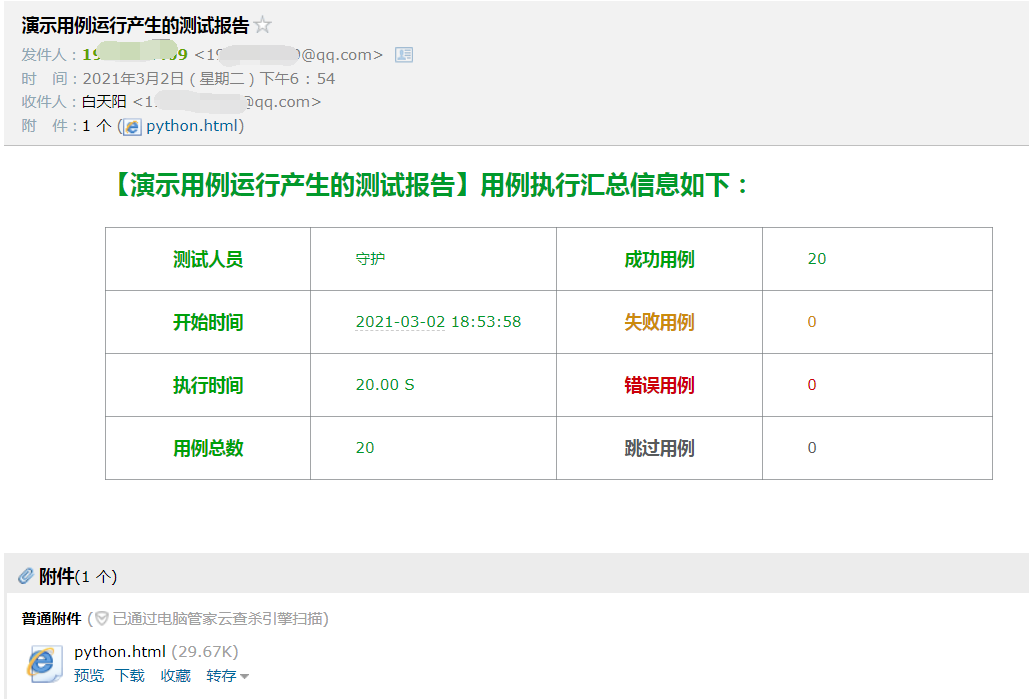
六、推送测试结果到钉钉
关于把测试结果推送到钉钉群,unittestreport里面进行了封装。执行完用例之后,调用TestRunner对象的dingtalk_notice方法即可。
参数介绍:
关于dingtalk_notice这个方法的参数如下,大家可以根据使用需求来进行选择。
- url: 钉钉机器人的Webhook地址
- key: (非必传:str类型)如果钉钉机器人安全设置了关键字,则需要传入对应的关键字
- secret:(非必传:str类型)如果钉钉机器人安全设置了签名,则需要传入对应的密钥
- atMobiles: (非必传,list类型)发送通知钉钉中要@人的手机号列表,如:[137xxx,188xxx]
- isatall: 是否@所有人,默认为False,设为True则会@所有人
- except_info:是否发送未通过用例的详细信息,默认为False,设为True则会发送失败用例的详细信息
案例代码:
import unittest from unittestreport import TestRunner # 收集用例到套件 suite = unittest.defaultTestLoader.discover(CASE_DIR) runner = TestRunner(suite) # 执行用例 runner.run() url = "https://oapi.dingtalk.com/robot/send?access_token=6e2a63c2b9d870ee878335b5ce6d5d10bb1218b8e64a4e2b55f96a6d116aaf5" # 发送钉钉通知 runner.dingtalk_notice(url=url, key='钉钉安全设置的关键字',secret='钉钉安全设置签名的秘钥') # 备注:关于钉钉群机器人的创建大家可以去看钉钉开放平台上的教程,关键字和秘钥,
# 根据创建钉钉机器人时设置的去添加,没有设置就不需要传这个参数。
url 获取方式:
- 百度搜索 “钉钉开放平台”
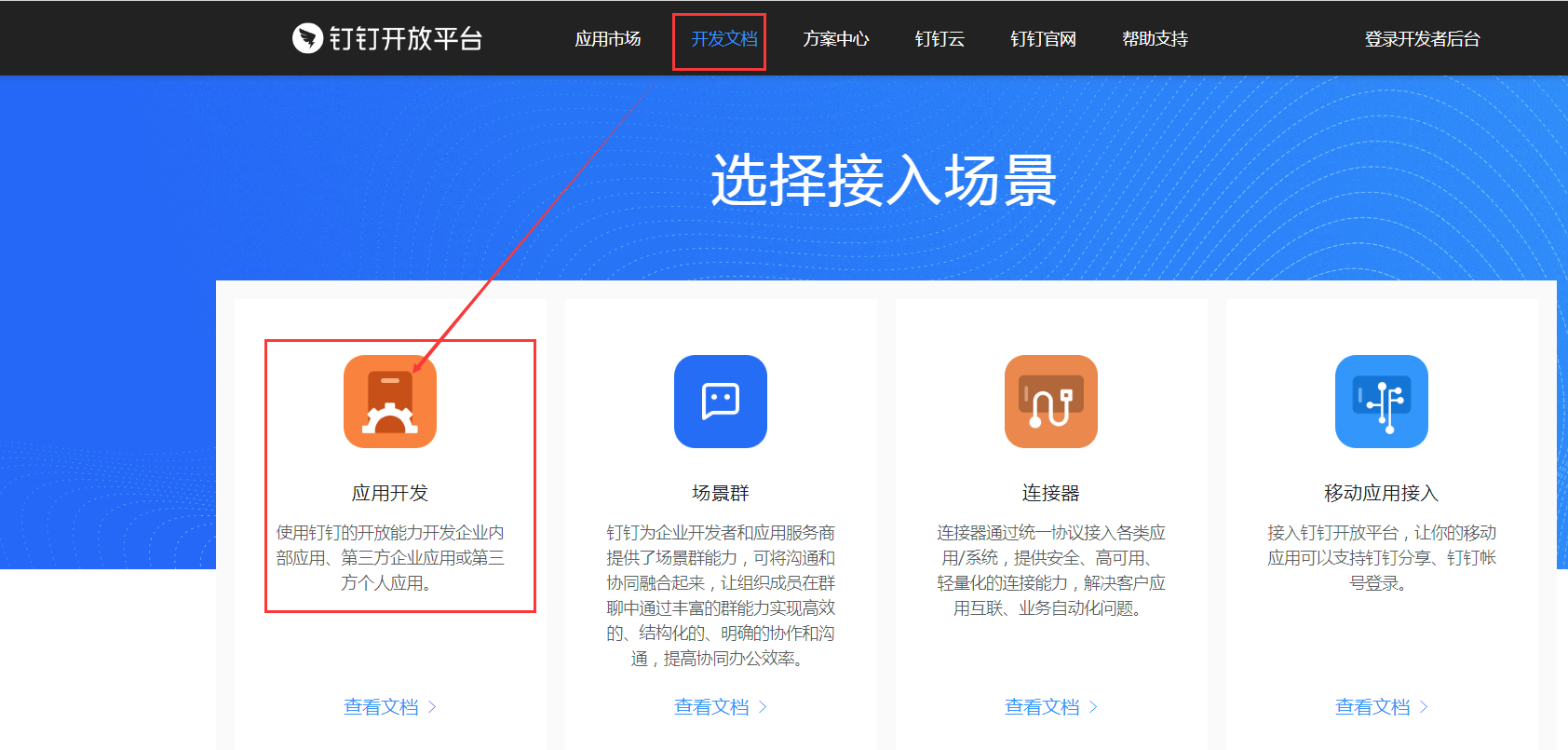
- 找到:服务端API >> 群机器人 >> 自定义机器人接入 >> 自定义机器人接入 ,按照文档步骤设置
- 链接(如果打不开按照上面查找):https://developers.dingtalk.com/document/app/custom-robot-access
钉钉收到样式:

七、推送测试结果到企业微信
目前也有不少的公司使用企业微信办公,自动化跑完之后,测试结果需要推送到企业微信群,所以把这个功能做了一下集成(其实大家自己去些也没多少代码)。执行完用例之后,调用TestRunner对象的weixin_notice 方法即可将测试结果推送到企业微信群。
参数介绍
- CHATID: 企业微信群ID
- ACCESS_TOKEN:调用企业微信API接口的凭证
- CORPID:企业ID
- CORPSECRET:应用的凭证密钥
案例代码
import unittest from tests.test_case import TestClass from unittestreport import TestRunner # 加载用例 suite = unittest.defaultTestLoader.loadTestsFromTestCase(TestClass) runner = TestRunner(suite=suite) # 运行用例 runner.run() # 推送测试结果到企业微信 # 方式一: runner.weixin_notice(chatid="企业微信群id", access_token="调用企业微信API接口的凭证") # 方式二: runner.weixin_notice(chatid="企业微信群id",corpid='企业ID', corpsecret='应用的凭证密钥')
*******请大家尊重原创,如要转载,请注明出处:转载自:https://www.cnblogs.com/shouhu/,谢谢!!*******






